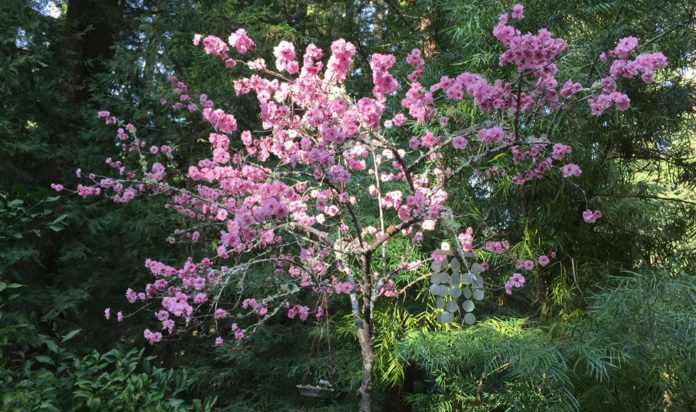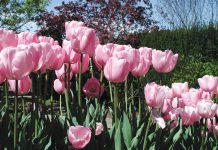One of my favorite classes when I attended Cal Poly San Luis Obispo was Plant Taxonomy. On the surface the subject sounds a little dry, but the professor was all about plant reproduction, which is quite exciting and more varied than you think. So with Valentine’s Day upon us, here are some interesting facts about how plants get together.
If you’re like me, you’ve caught a case of pre-spring fever. How can we help it when the flowering plums are covered with hundreds of blossoms, the saucer magnolia flowers are opening and the flowering quince are in full bloom? When I lived in Bonny Doon, my Blireiana flowering plum was always in bloom around the time of Valentine’s Day. I would have my picture taking under it posing with my presents. Here’s a reminder of how flowering plants reproduce.
Blireiana flowering plums are in the rose family. They have perfect flowers meaning that they have both male and female reproductive parts on the same flower. They depend on pollinators like bees, moths and hummingbirds to transfer pollen.
Some flowering plants like oaks, spruce, corn, pumpkin and birch trees have separate male and female flowers on the same plant making them self-pollinating. They are monoecious, meaning “single house.”
Dioecious plants have male flowers on one plant and female flowers on another. Examples are myrica, gingko, juniper, spinach, walnut, asparagus and ash.
Blooming at this time of year is the fragrant Daphne. How does it reproduce? Daphne have powerfully fragrant flowers filled with nectar to attract pollinators, such as bees and other insects. They are monoecious.
Hellebores fall into this category also (kinda). Hellebore flowers are also protogynous, which means that the carpels (female reproductive organs) nature before the stamens (male reproductive organs). This encourages cross-pollination. But although hellebores are protogynous, they are also self-fertile. Seems like they have all the bases covered—they are never out of bloom starting in early winter and blooming into late spring.
Looking around my little garden I enjoy the cyclamen flowers at this time of year also. Cyclamen are mostly monoecious. Many fruit trees fall into this category, too, like almonds, apricots, cherries, nectarines, peaches and prunes.
Not all flowers are large and brightly colored. Some flowering plants, like grasses, have flowers that are tiny and may even be green.
Other plants have no flowers at all. Mosses reproduce from male and female mosses, which produce spores. Conifers produce two types of cones on the same tree. Wind blows the pollen to another cone, which combines to make a baby conifer that lives in a seed inside the cone.
So on this Valentine’s Day, take a minute to appreciate plants and all they provide for us.
Jan Nelson, a landscape designer and California-certified nursery professional, will answer questions about gardening in the Santa Cruz Mountains. Email her at ja******@*ol.com, or visit jannelsonlandscapedesign.com.













